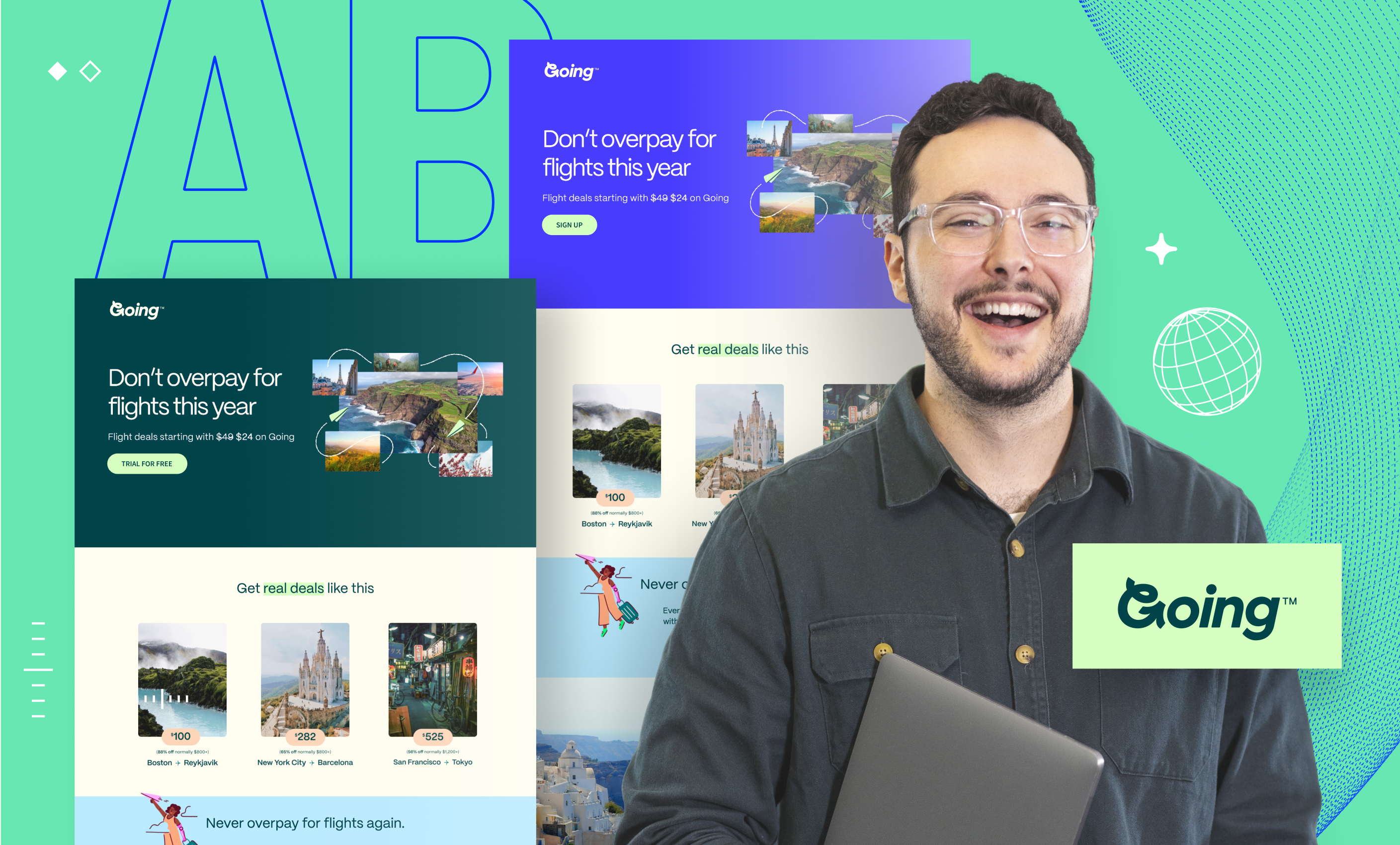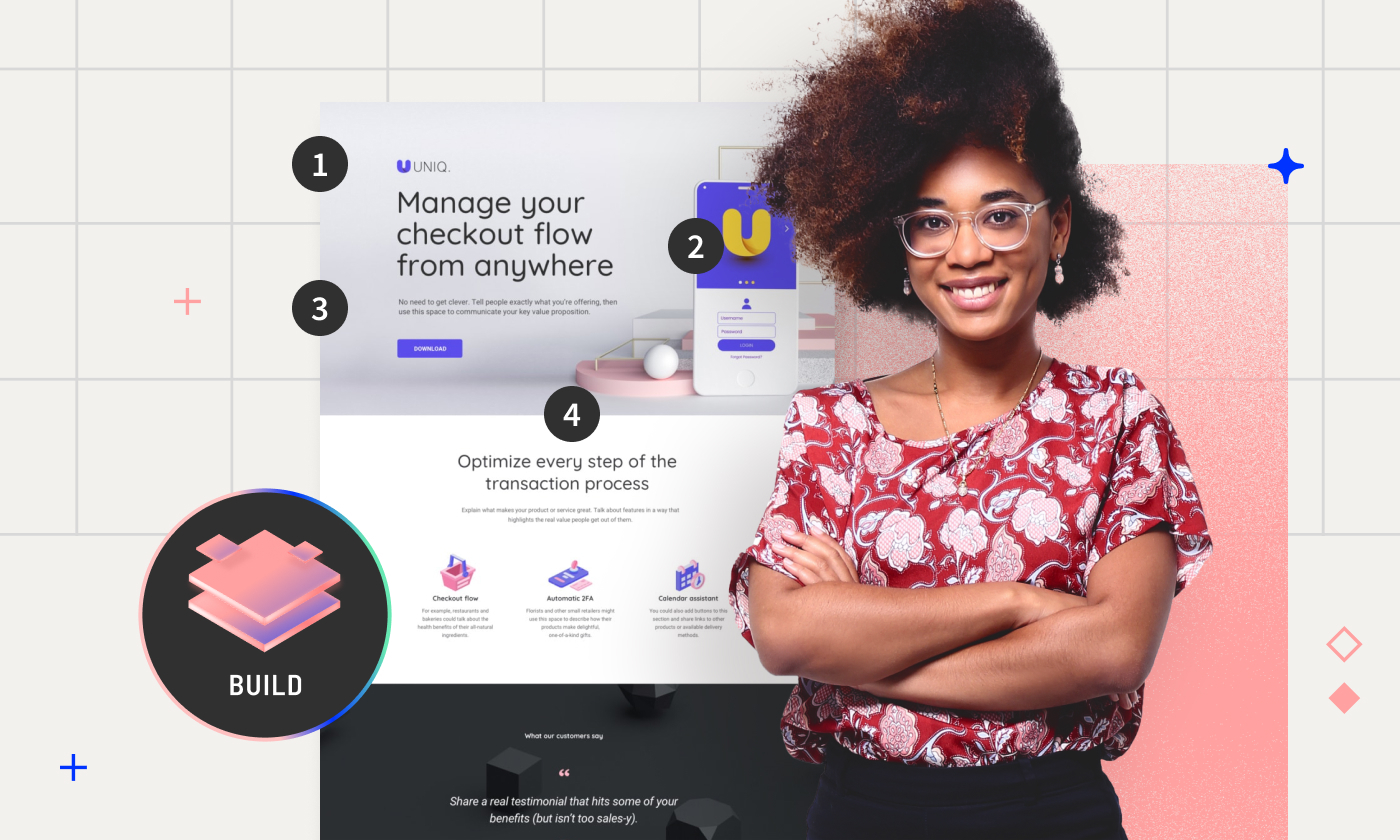Josh Gallant
Josh is the founder of Backstage SEO, an organic growth firm that helps SaaS companies capture demand. He’s a self-proclaimed spreadsheet nerd by day, volunteer soccer coach on weekends, and wannabe fantasy football expert every fall.
» More blog posts by Josh Gallant
Which factors influence ecommerce sales the most?
Several factors play a crucial role in the success of ecommerce sales.
Things like the overall user experience on your website, the attractiveness and clarity of your product presentations, the ease of the purchasing process, and more can make or break your ecommerce engine.
The good news is, there are plenty of levers you can pull across each key area to increase your ecommerce sales—22 of which we’ll be covering in this post.
In short, here are the most important factors that influence how well-oiled your ecommerce sales machine:
- How you present your product to visitors
- How potential customers purchase your product online
- How you tap into customer reviews and feedback
- How well you build customer loyalty and retain customers
- How you market your products and drive (high-quality) traffic
22 ways to increase your ecommerce sales
Let’s get down to business.
We’ve outlined 22 different tactics you can use to drive more ecommerce sales, split into the five buckets we mentioned above. If you’d like, you can use those links to jump straight to a specific section.
To be clear here too:
You don’t need to do ALL 22 of these to see success.
As you scroll through this post, jot down the ideas that jump out to you and feel most relevant to your ecommerce business. For example, if you know your product pages need some TLC, write down and experiment with the product page tips. If your pages are in good shape but you’re not driving enough (or the right) traffic, skip to the PPC and marketing tips.
Without further ado, let’s get started.
Product presentation and product page tips
First, your products need to be presented well. If your product pages look sloppy and aren’t properly optimized to convert visitors, your sales charts aren’t going to be as up-and-to-the-right as you’d like.
In this section, we’ll cover some practical ways to improve the layout, design, and performance of your product pages by leaning into some ecommerce landing page best practices.
- Apply landing page best practices to your product pages
- Write compelling product descriptions
- Use high-quality product images
- Choose the right ecommerce and landing page platforms
- Experiment with popups and sticky bars
- A/B test your product pages, pricing, marketing messages, etc.
1. Apply landing page best practices to your product pages
Applying landing page best practices to your product pages is essential for boosting ecommerce sales. These strategies ensure potential customers have a seamless and engaging experience, making them more likely to convert.
- Use clear and compelling calls to action (CTAs): Your CTAs should be visually prominent and use action-oriented language like “Buy Now” or “Add to Cart” to guide visitors toward making a purchase.
- Simplify navigation and minimize distractions: A clean and simple layout helps online shoppers find what they need quickly, reducing the likelihood of abandonment. Remove any unnecessary elements that could distract from the purchasing process.
- Use trust signals like security badges and customer reviews: Displaying security badges, guarantees, and positive reviews reassures potential buyers that your ecommerce business is reliable, encouraging them to complete their purchase.
Most ecommerce product pages already do a good job of this, but Branch is a good example because they also use high contrast to make their simple “Add to Cart” button stand out.
2. Choose the right ecommerce and landing page platforms
Selecting the right ecommerce tool and landing page platform is crucial for your ecommerce business’s scalability and success. If you’re trying to grow sales with less-than-stellar tools in your toolbelt, all you’re doing is making the job far tougher than it needs to be.
- Evaluate platforms based on scalability, customization, and ease of use: Choose a platform that can grow with your business, offers customization options, and is user-friendly. This makes sure your site remains functional and attractive as your business expands.
- Consider integration with marketing tools and payment gateways: Your platforms should integrate seamlessly across marketing tools, payment options and tools, inventory management tools, etc. This makes it easier to manage campaigns and transactions efficiently.
- Use platforms with built-in A/B testing: No matter how your product pages or landing pages are set up, you will be A/B testing at some point (and if you ask us, you should be A/B testing yesterday, today, tomorrow, and every day beyond that). Make sure your landing page and product page tools come with A/B testing features.
We may be slightly biased here, but Unbounce has helped countless store owners, operators, and marketers grow ecommerce sales.
And to be crystal clear, you absolutely do not need to ditch Shopify, BigCommerce, or whichever ecomm platform you’re running on. You can still use Unbounce alongside these tools to build and A/B test campaign-specific ecommerce landing pages, new product pages, popups and sticky bars, and more. All without needing in-house dev or design resources (shoutout to the drag-and-drop builder).
Here are a few examples and success stories to check out:
3. Write compelling product descriptions
Crafting compelling product descriptions is a key component in driving ecommerce sales. Well-written descriptions not only inform but also engage and persuade potential buyers.
If you’re struggling to come up with good ideas or stuck staring at a blank page, you can use Smart Copy inside Unbounce to work alongside your very own AI copywriting assistant.
- Highlight unique features and benefits: Clearly outline what makes your product special and how it can meet your customers’ needs or solve their problems. This helps potential buyers understand the value of your product.
- Use persuasive and emotive language: Create a vivid picture of the positive experience your product offers. Instead of just listing features, describe how it will enhance the customer’s life or solve a specific issue.
- Include keywords naturally to improve SEO: Integrate relevant keywords seamlessly into your descriptions. This boosts your product’s visibility in search engines, making it easier for potential buyers to find you.
Jinx sells healthy puppy food and uses their product descriptions to explain exactly what makes their food unique.
4. Use high-quality product images
High-quality product images are essential for creating a positive first impression and convincing potential buyers to make a purchase. Visuals play a crucial role in online shopping, where customers cannot physically interact with products.
- Showcase multiple angles and details: Provide a comprehensive view of your product by including images from different angles and highlighting key features. This helps potential buyers feel more confident in their purchase decisions.
- Include zoom functionality and lifestyle images: Allow customers to zoom in on product images to see fine details. Additionally, use lifestyle images to show the product in use, helping customers envision how it fits into their lives.
- Ensure images are optimized for fast load times: Optimize your images to maintain high quality while ensuring quick loading times. Slow-loading images can frustrate online shoppers and lead to higher bounce rates.
Italic uses a minimalistic style across their site, with large, elegant-looking images to illustrate a luxurious vibe that matches how they’re positioning their products.
5. Experiment with popups and sticky bars
Using popups and sticky bars can effectively capture customer attention and drive ecommerce conversions. These tools provide timely, relevant information or offers that can nudge potential customers towards making a purchase.
- Use popups for exit intent or special offers: Implement exit intent popups to capture customers about to leave your site, offering them discounts or special deals to encourage them to stay and complete their purchase.
- Implement sticky bars for important announcements or promotions: Sticky bars remain visible as customers browse, ensuring they see important messages like ongoing sales or free shipping offers. This keeps promotional information front and center.
- A/B test different designs and messaging: Experiment with various designs and messages for your popups and sticky bars. Analyze which combinations yield the highest conversion rates and adjust accordingly.
Caraway uses a clean full-screen popup that doesn’t necessarily share a novel, never-seen-before offer—everyone does free shipping these days—but still keeps things simple and straightforward.
The headline is clear—free shipping—as is the call to action. Bonus points for not using unnecessarily negative copy like “No I hate saving money” on their decline button too.
6. A/B test your product pages, pricing, marketing messages, etc.
A/B testing is a powerful tool for optimizing your ecommerce site. By comparing different versions of your pages, you can identify what resonates best with your audience and drives conversions. Of course, you can use the Unbounce platform to A/B test anything and everything on your product landing pages, too.
- Test different layouts, headlines, and CTAs: Experiment with different elements like page layouts, headline styles, and CTA buttons. Determine which combinations lead to higher engagement and sales.
- Analyze results and implement the most effective variations: Regularly review the performance data from your tests. Implement the variations that perform best to continuously improve your site’s effectiveness.
- Continuously optimize based on data-driven insights: Use the insights gained from A/B testing to make informed decisions. Continually refine your product pages, pricing strategies, and marketing messages to enhance user experience and conversion rates.
Checkout and sales process tips
Once your products are displayed in a way you’re proud of on your product pages and you’ve been able to successfully get visitors to hit the beautiful “add to cart” button, the next step is simple:
Simple, but not easy, of course.
WIth products in the cart already, the focus here is all about how you can strengthen your checkout experience. The easier and more compelling you make it for visitors to complete their purchases, the more likely they’ll be to… complete their purchases.
Let’s run through a few tips you can experiment with.
- Optimize your checkout process
- Add upsells and down-sells to your sales funnel
- Offer multiple payment options
7. Optimize your checkout process
Optimizing your checkout process is vital for reducing cart abandonment and boosting sales. A streamlined and user-friendly checkout can make the difference between a completed purchase and a lost customer.
- Get creative with your copy and checkout experience: Checkout doesn’t always need to be boring and basic. Sometimes, adding some creativity and customization for each user can boost the likelihood of them purchasing.
- Simplify the checkout steps to reduce friction: Reduce the number of steps required to purchase. A single-page checkout or a clear, multi-step process can help maintain customer focus and reduce drop-offs.
- Offer guest checkout options: When customers can complete their purchase without creating an account, you remove a significant barrier, especially for first-time buyers who prefer a quicker checkout experience.
- Use a mobile-friendly design: Make sure your checkout process is optimized for mobile devices. A responsive design and easy-to-use interface are crucial as more customers shop on their smartphones and tablets.
One great example of a personalized checkout process is BarkBox—a dog toy and treat subscription box.
They use a multi-step, quiz-style checkout process that asks for info about your pup like their name, size, and birthday, then present you with custom-tailored subscription box options. And throughout the process, they’re using dynamic text replacement to add your puppy’s name to the pages.
Here’s how the process looks:
Step 1: Share their name and if they’re a “good girl” or “good boy”.
Step 2: Share how much your pup weighs (with their name in the question).
Step 3: Share the breed of your pup, again with their name in the question.
Step 4: Choose a subscription option tailored to your puppy.
Step 5: Start the checkout process. Notice their guarantee is automatically personalized with your pup’s name, as is the name of the product you’re buying.
8. Add upsells and down-sells to your sales funnel
Integrating upsells and down-sells into your sales funnel can significantly boost your revenue per transaction. By offering related products or higher-end options, you can maximize the value of each sale.
- Recommend higher-end products or complementary items: Suggest premium versions of products or items that complement the original purchase. This can encourage customers to upgrade or add more to their cart.
- Use personalized suggestions based on customer behavior: Use data from previous purchases and browsing history to make personalized recommendations. Tailored suggestions are more likely to resonate with customers and result in additional sales.
- Display offers prominently during the checkout process: If you have upsell and down-sell offers, make sure they’re clearly visible at strategic points in the checkout process, such as on the cart page or during payment. This increases the chances of customers considering these additional options.
Quip adds an upsell directly on their cart page—a subscription offer for $20/year that also adds discounts throughout the year. They make it as simple as pressing the “Add to cart” button too. Just like that, you can turn a $25 purchase into a $45 purchase, with an even greater likelihood of future purchases given that it’s a subscription service.
9. Offer multiple payment options
Providing multiple payment options is essential for accommodating your customers’ diverse preferences. Plus, a flexible and secure payment process can enhance trust and convenience, leading to higher conversion rates.
- Offer common payment methods like major credit cards and Apple Pay: Try to support as many widely used payment options as possible to cater to a broad audience. This includes major credit cards like Visa and Mastercard, PayPal, and digital wallets like Apple Pay and Google Pay.
- Consider financing options: Financing or installment plans can make higher-priced items more accessible, encouraging customers to make larger purchases. This won’t be the right fit for every brand, so make sure to evaluate if it’s worth experimenting with on your specific store.
- Use a secure and seamless payment experience: Use trusted payment gateways and display security badges to reassure customers. It may seem small, but a smooth, secure checkout process that feels familiar to customers will build trust, decrease purchase anxiety, and reduce cart abandonment.
Customer feedback and review tips
Social proof is still the name of the game.
In fact, 92% of consumers hesitate to buy when no customer reviews are available, and 66% say positive reviews are most important when purchasing.
So the questions are: How can you get more positive reviews, and what should you do with them when you do get them?
- Collect and analyze customer feedback
- Feature customer reviews on your product pages to build trust
- Encourage user-generated content
10. Collect and analyze customer feedback
Gathering and analyzing customer feedback is crucial for understanding your customers’ needs and improving your offerings. This process helps identify areas for improvement and boosts customer satisfaction.
- Use surveys, feedback forms, and social media listening: Implement various methods to gather feedback from your customers. Surveys and feedback forms can provide direct insights, while social media listening can reveal customer sentiments and trends.
- Analyze feedback to identify common pain points and opportunities: Regularly review the collected feedback to spot recurring issues or suggestions. This analysis can highlight areas where your products or services can be enhanced.
- Implement changes based on customer insights: Use the insights gained from feedback to make informed adjustments to your products, services, or website. Addressing customer concerns shows that you value their input and are committed to improvement.
11. Feature customer reviews on your product pages to build trust
Featuring customer reviews on your product pages is a powerful way to build trust and influence potential buyers. Positive reviews act as social proof, reassuring visitors about the quality and reliability of your products.
- Highlight positive reviews and testimonials: Promote happy customer reviews on your product pages. This can help potential buyers feel more confident in their purchase decisions.
- Display star ratings prominently: Use star ratings to give visitors a quick visual indication of product quality. High ratings can significantly boost a potential buyer’s confidence.
- Allow users to filter and sort reviews: Enable filtering and sorting options for reviews so customers can easily find the most relevant feedback. This can enhance their shopping experience and help them make informed decisions.
Brooklinen does this well on their product pages in a few ways. First, above the fold, they show reviews and a star rating (as most pages do) but also a live tracker of how many people have the product in their cart right now.
Second, below the fold, they have a dedicated section with customer reviews. They show the overall rating and number of reviews (a trust signal on its own), and a complete list of filterable reviews with a few positive reviews featured at the top.
12. Encourage user-generated content
Encouraging user-generated content (UGC) can greatly enhance your ecommerce site by adding authentic, relatable content created by your customers. UGC builds trust and engagement, providing social proof that can influence potential buyers.
- Run campaigns to solicit reviews, photos, and videos: Encourage customers to share their experiences with your products through reviews, photos, and videos. Offer incentives like discounts or rewards to motivate participation.
- Share user-generated content on social media and product pages: Feature customer photos and videos on your social media channels and product pages. This not only showcases real-life use cases but also fosters a sense of community.
- Reward customers for contributing content: Implement a rewards program that recognizes and rewards customers for their contributions. This can include discounts, loyalty points, or special recognition.
Customer loyalty and engagement tips
Loyal and engaged customers make repeat purchases and tell their friends about you. If the goal is to increase ecommerce sales, both of those things are right on the money.
Easier said than done, though.
What can you do to increase customer loyalty and build an army of raving fans?
There are some simple levers you can pull on your website, and some more complex initiatives you can launch to do exactly that. Let’s get into it.
- Enhance customer loyalty by launching loyalty programs
- Improve customer lifetime value through repeat purchase campaigns
- Prioritize customer engagement initiatives
- Provide excellent customer service
13. Enhance customer loyalty by launching loyalty programs
Building customer loyalty is essential for sustaining long-term success and driving repeat purchases. Loyalty programs can help you retain customers and increase their lifetime value by offering incentives and rewards.
- Create loyalty programs with tiered rewards: Design a loyalty program that offers different reward levels based on customer spending or engagement. This encourages customers to continue purchasing to reach higher tiers and earn better rewards.
- Offer exclusive discounts and early access to sales: Reward loyal customers with exclusive discounts, special offers, or early access to sales events. This makes them feel valued and appreciated, fostering a stronger connection to your brand.
- Personalize loyalty rewards based on customer preferences: Use data to tailor rewards to individual customer preferences. Personalized rewards are more meaningful and can significantly enhance customer satisfaction and loyalty.
Harry’s uses a simple subscription-based loyalty program that unlocks greater and greater savings as you stay longer and purchase more.
You can of course get more creative than this depending on the product, but this is a good example that simple isn’t a bad thing when you’re just getting started with a loyalty program.
14. Improve customer lifetime value through repeat purchase campaigns
Increasing customer lifetime value (CLV) through repeat purchase campaigns is crucial for maximizing revenue. You can boost profitability and build lasting relationships by encouraging customers to return and buy again.
- Use email marketing to promote repeat purchases: Send personalized emails with product recommendations, special offers, and reminders to encourage previous buyers to return. Highlight new arrivals or complementary products to spark interest in the process.
- Offer incentives for recurring purchases: Provide discounts, loyalty points, or other rewards for repeat purchases. These incentives can motivate customers to choose your store over competitors for future needs.
- Highlight related products or services: Show related or complementary products on your website and email campaigns. This helps customers discover new items they might need, increasing the likelihood of additional purchases.
15. Prioritize customer engagement initiatives
Focusing on customer engagement initiatives is key to building strong, lasting customer relationships. Engaged customers are more likely to be loyal customers, make repeat purchases, and advocate for your brand.
- Use personalized interactions through email and social media: Tailor your communications to each customer’s preferences and behaviors. Personalized emails, social media messages, and targeted ads can make customers feel valued and understood.
- Create engaging content that resonates with your audience: Develop content that addresses your customers’ interests and needs. This can include blog posts, videos, webinars, and interactive social media posts that encourage participation and sharing.
- Host events, webinars, or live chats: Organize events and live interactions to engage directly with your customers. These activities provide a platform for real-time feedback, questions, and discussions, fostering a deeper connection.
Glossier runs a ton of local community events all over the world, and these events lead to massive amounts of user-generated content through TikTok.
16. Provide excellent customer service
Providing excellent customer service is essential for maintaining customer satisfaction and loyalty. A positive customer service experience can turn one-time buyers into repeat customers and advocates for your brand.
- Train support teams to handle inquiries efficiently: Make sure your customer support team is well-trained to address questions and resolve issues quickly and effectively. Empower them with the knowledge and tools needed to provide top-notch service.
- Use chat options for real-time assistance: Implement live chat on your website to offer immediate help to customers. This can reduce wait times and improve the overall shopping experience.
- Follow up with customers: After resolving an issue or completing a purchase, follow up with customers to make sure they are satisfied. This extra step shows you care about their experience and are committed to their happiness.
Marketing and social media tips
With your product pages in a good place, your checkout process now well-oiled, positive reviews and ratings all over the place, and loyalty programs in place to drive repeat purchases and referrals… What’s left?
How you present your brand and products to the market can massively influence how well your ecommerce sales engine runs. If potential customers already know and love your brand from what they’ve been seeing you share on your social channels or in your ads, the chances of them converting when they do reach your website will be much higher than if they came in completely cold.
Plus, there are some specific “marketing optimization” levers you can pull that relate to SEO and PPC specifically that’ll help you reach your target audience as they’re looking for what you sell.
- Use social media platforms effectively
- Send promotional emails strategically
- Offer exclusive discounts to drive sales
- Focus on search engine optimization on your product pages
- Run targeted PPC ads and marketing campaigns
- Run retargeting ads or “win back” campaigns
17. Use social media platforms effectively
Social media platforms are essential for reaching a wider audience and driving engagement. By effectively using these channels, you can boost brand awareness, foster customer relationships, and increase sales.
- Choose platforms that align with your target audience: Focus on social media platforms where your potential customers are most active. This ensures that your efforts are reaching the right people and maximizing engagement.
- Post regularly and engage with followers: Maintain a consistent posting schedule to keep your audience engaged. Respond to comments, messages, and mentions to build a sense of community and show that you value their input.
- Use influencer marketing to expand reach: Partner with influencers who align with your brand values and have a strong following. Their endorsement can introduce your products to new potential customers and lend credibility to your brand.
Magic Spoon Cereal has built an Instagram audience of 400K+ that perfectly matches its brand vibes with fun, vibrant colors and product visuals. It’s also using its highlights section to share where you can buy, which flavors it has, an “us vs. them” comparison (which is awesome), and FAQs.
18. Send promotional emails strategically
Strategic email marketing is a powerful tool for driving sales and nurturing customer relationships. Well-timed and personalized promotional emails can encourage repeat purchases and keep your brand top-of-mind.
- Segment your email list for targeted messaging: Divide your email list into segments based on customer behavior, preferences, and purchase history. This allows you to send more relevant, personalized emails that resonate with each group.
- Personalize email content and offers: Use customer data to tailor your email content. Personalized subject lines, product recommendations, and special offers can increase open rates and conversions significantly.
- Track and analyze email performance metrics: Monitor key metrics like open rates, click-through rates, and conversions. Use this data to refine your email marketing strategy, ensuring your campaigns are effective and engaging.
19. Offer exclusive discounts to drive sales
Offering exclusive discounts is an effective strategy to attract new customers and reward loyal ones. Special promotions can create a sense of urgency and encourage immediate purchases.
- Promote time-sensitive discounts to create urgency: Use limited-time offers to encourage potential buyers to act quickly. Countdown timers and clear expiration dates can help emphasize the urgency.
- Use discount codes for specific customer segments: Tailor discount codes for different customer groups, such as first-time buyers, loyal customers, or those who have abandoned their carts. Personalized offers can increase the likelihood of conversions.
- Track the effectiveness of discount campaigns: Monitor the performance of your discount campaigns to see which ones drive the most sales. Use this data to optimize future promotions to boost the likelihood of them being successful and cost-effective.
20. Focus on search engine optimization (SEO) on your product pages
Optimizing your product pages to rank well in search engines like Google is crucial for driving organic traffic and increasing visibility in the places where your buyers are actively searching for what you sell. Effective SEO strategies help potential buyers find your products more easily, increasing sales.
- Optimize product titles, descriptions, and images: Use relevant keywords naturally in your product titles, descriptions, and image alt texts. This helps search engines understand your content and improves your rankings.
- Use relevant keywords throughout your content: Research and incorporate keywords your target audience will likely search for. This increases the chances of your product pages appearing in search results.
- Monitor and improve page load times: Make sure your product pages load quickly to provide a positive user experience and reduce bounce rates. Faster loading times can also improve your search engine rankings.
A good example of this tactic done well is Bonobos.
Their men’s dress shirts category page is ranking in Google for over 6,000 unique keywords organically—some of which are driving hundreds of organic visitors to the page every single month.
21. Run targeted PPC ads and marketing campaigns
Running targeted PPC ads and marketing campaigns can significantly boost your ecommerce sales by reaching potential buyers actively searching for products like yours. These campaigns allow you to drive high-quality traffic to your site and landing pages quickly and efficiently.
- Use Google Ads to reach potential buyers: Create targeted ads on Google to capture search traffic. Tailor your ads to specific keywords your potential customers use, increasing the chances that your products appear at the top of search results.
- Create ad campaigns that align with your marketing goals: Define clear objectives for your PPC campaigns, whether they’re increasing sales, generating leads, or boosting brand awareness. Align your ad copy, visuals, and landing pages with these goals for maximum impact.
- Track ROI and adjust campaigns based on performance: Continuously monitor your ads’ performance to understand which ones deliver the best return on investment. Use this data to optimize your targeting, ad copy, and budget allocation.
There’s so much nuance to PPC strategies for ecommerce that we couldn’t possibly cover in this one section, but one simple way to think about it is this:
When someone is searching for what you sell, it’s best to be there as an option.
For example, if someone is searching Google for adjustable standing desks, there’s plenty of ad real estate you could be bidding on to try to win visibility.
22. Run retargeting ads or “win back” campaigns
Retargeting ads and “win back” campaigns are powerful tools for re-engaging customers who have interacted with your site but haven’t purchased. These strategies help bring back lost customers and encourage repeat business.
- Use retargeting ads to re-engage abandoned cart users: Display ads to customers who have added items to their cart but didn’t complete the purchase. Highlight the items they left behind and offer incentives, such as discounts or free shipping, to encourage them to return and finalize their purchase.
- Create “win back” campaigns for inactive customers: Identify customers who haven’t purchased in a while and reach out with personalized offers to reignite their interest. This could include special discounts, new product announcements, or personalized product recommendations.
- Personalize messaging to entice return purchases: Tailor your retargeting and “win back” messages based on customer behavior and preferences. Personalized messages are more likely to resonate and prompt customers to return to your site.

![[Build – MOFU – Ecommerce] Industry Page – V1 Ecomm landing pages](https://unbounce.com/photos/blog-visual-cta-generic-ecomm-green.jpg)





